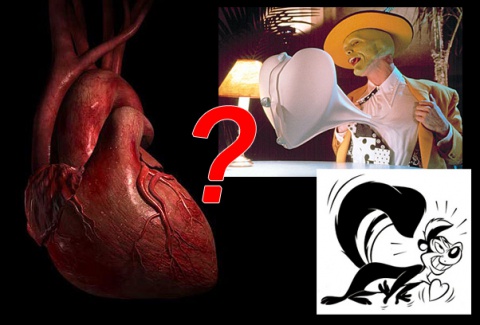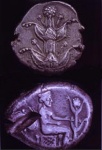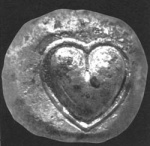I Love You ♥
In the above image you can see variations on the heart shape, which is usually associated with love or being in love. But it’s also associated with the (human) heart, which is where I assume this shape gets its name from. At least, this is what is generally accepted by societies around the world. Lovers like to send this heart shape to each other, especially on Valentine’s day, to tell each other that they’re in love with one another. But what are you really saying to a person when you send this heart shape to him/her?
I can still remember being a little puzzled while looking at an image of the human heart back when I was in high school during a biology lesson, because of the fact that the human heart looked nothing like this shape. And yet I grew up with people and information around me suggesting that this is what a human heart looked like. I’m sure you can remember the cartoons and movies where people are in love and you see this heart shape coming out of their chests, or see little heart shapes floating around their heads. And I think the likely reason why this shape is associated with love and the human heart is because typically when you’re in love or “heartbroken”, there can be an intense feeling inside your chest. But this feeling has nothing to do with your real heart. And the heart shape also doesn’t look like a real human heart. So where does this shape really come from, and why is it associated with the feeling of love?
For the answers to these questions we have to go back a couple of hundreds of years ago to Greece:
Approximately 2,600 years ago– around 630 BCE– the Greek island of Thera was plagued by drought and overpopulation. According to legend, an assortment of settlers were selected to sail south to establish a colony in more hospitable climes. The men and women apprehensively put to sea, and the gaggle of enterprising Greeks eventually erected the city of Cyrene on Africa’s northern tip. There, the settlers encountered a local herb which would ultimately bring them and their progeny fantastic wealth.
The prized plant became such a key pillar of the Cyrenean economy that its likeness was stamped upon many of the city’s gold and silver coins. The images often depicted a regal-looking woman sitting in a chair, with one hand touching the herb and her other hand pointing at her genitals. The plant was known as silphium or laserwort, and its heart-shaped fruit purportedly brought the ancient world a highly sought-after freedom: the opportunity to enjoy sex with very little risk of pregnancy.
The silphium plants were giant fennels which grew wild along the dry hillsides of the Mediterranean coast. It didn’t take long for the Greek settlers to discover its value as a food source, and the vegetable flesh came to be prized as a delicious garnish, while pleasant perfumes were coaxed from its yellow blossoms. Over time further uses for the wild fennel were found, such as the resin extracted from its stalks and roots which was used to treat cough, sore throat, fever, indigestion, snake bite, “warts in the seat,” epilepsy, and a host of other disagreeable ailments. But of all of the plant’s virtues, the silphium was certainly most prized for its pregnancy-preventing properties.
As word of the birth-control wonder-herb spread through ancient Europe, Africa, and Asia, a market for the versatile fennel developed rapidly. The seeds became widely used among the world’s wealthier nations, including the citizens of ancient Greece, Rome, Egypt, and India. By some accounts the silphium seed was also a potent aphrodisiac, a property which considerably compounded its perceived value. The Roman bard Catullus famously alluded to its sexual properties in one of his love poems, where he declared that he and his lover would share as many kisses as there were grains of sand on Cyrene’s silphium shores. More plainly, “We can make love so long as we have silphium.”
More about silphium:
Long before hippies thought hemp could solve all the world’s problems, Romans used an alleged wonder plant of the carrot and parsley family called silphium. It was a sort of giant fennel that grew wild near Cyrene, an ancient coastal city in North Africa. Silphium had many uses — perfume from its flowers, food from its stalk, and medicine from its juice (or resin) and roots. The Romans didn’t discover the plant’s properties — there’s evidence the Greeks and Egyptians used it as a contraceptive as early as the seventh century BC on the advice of physicians, who recommended a monthly dose that mixed a lump of resin the size of a chickpea with water. The Roman scholar Pliny the Elder described use of the resin (called laser or laserpicium) “with soft wool as a pessary to promote the menstrual discharge.” Menstrual discharge, of course, means no pregnancy. One physician in the second century AD named Soranus claimed a special recipe using silphium had been used to terminate pregnancies. In Contraception and Abortion from the Ancient World to the Renaissance (1992), medical historian John Riddle claims that modern studies show the recipe and others like it would work.
It’s easy to see why silphium would be so important to the Greek and other civilizations back then. Sex is a very important in life, and this was most certainly also the case in these ancient societies. It’s clear that repression of sexual desires can be destructive not only for an individual, but also for society as a whole. Dr. Sigmund Freud established sexual desires as the primary motivating forces of human life. Silphium, used as a method for birth control, enabled these societies to be able to enjoy sex and express their love for each other as much as they wanted without the risk of pregnancy. It was so important to them in fact, that images of the plant and its seed were stamped into their gold and silver coins.
And if you look at the image of the Cyrene coin on the right, it shows what the seed/fruit of the silphium plant looked like. And that is an exact match with the shape of “the heart” that we’re all so familiar with and which is used to express the feeling of love these days. It should be clear to you, now that you have this information, why this “heart” shape is used as a symbol of love. Because of the fact that silphium was very important and used during the act of making love hundreds of years ago, it automatically became associated with love. And this is really the reason why love is associated with this “heart” shape, not because it represents a human heart!

I love you = I want to have sex with you
So from now on when you send a “heart” to someone, keep in mind what you are saying to that person: You are telling that person that you want to use silphium (birth control) with him/her, which means that you are essentially telling that person that you would like to have sex with him/her. And when you think about it, that makes a lot of sense!




Comments
There are 0 responses. Follow any responses to this post through its comments RSS feed. You can leave a response, or trackback from your own site.